#FairyBasics
Text
Scottish Folklore Songs (Historic Recordings)

The site Tobar An Dualchais is a collection of historic audio recordings in Scotland, and that includes songs. I collected just some of the folklore related ones into a list for you all.
I have no talent in singing, so I will have to leave that up to the rest of you. Some are in English, and other are in Gaelic.
Kelpies and Each-Uisge 🐎🌊
(link) A MHÒR, A MHÒR, TILL RID MHACAN.
"This song, which was used as a cradle song, was said to have been a lament composed by a water-horse(each-uisge) whose mortal lover had gone, taking their child with her. He is pleading with her to return. "
(Recorded in 1956)
(link) A GHAOIL LEIG DHACHAIGH GU MO MHÀTHAIR MI
"This song takes the form of a conversation between a girl and a water-horse. The girl is asking him to let her return home to her mother. The water-horse has other ideas. It is clear from the last verse that the girl escaped. "
(Recorded in 1954)
(link) 'ILLE BHIG, 'ILLE BHIG SHUNNDAICH Ò
"This is a fairy song. It was said to have been composed by a girl who was in love with a water-horse. As the song describes, he was killed by her brothers. The song lists some of the gifts he had promised to give the girl. "
(Recorded in 1963)
Mermaids 🧜♀️
(link) ÒRAN NA MAIGHDINN-MHARA
"In this song a mermaid says that she was deceived. She fell in love with a man even though he was human and she was a mermaid. Her sleep is unsettled when there is bad weather. "
(Recorded in 1963)
Selkies:
(link) THE GREAT SELKIE OF SULE SKERRY
"Supernatural ballad in which a woman bears a son to a selkie."
(Recorded in 1973)
(link) THE SELKIE
"The woman is speculating on who her baby's father is, when he appears and tells her he is Gunhaemilar and he is a selkie [seal man]. She is distraught and turns down his proposal of marriage. He tells her to nurse the baby for seven years, then he will return and pay her. He comes back and she asks him to marry her, but he rejects her in the same words she used to turn him down. He says he will put a gold chain round his son's neck so she will know him. She marries a gunner who shoots both the selkie and his son and she dies of a broken heart. "
(Recorded in 1971)
(link) UNKNOWN
"A Shetland song mentioning the selkies."
(Recorded in 1985)
Other:
(link) MORAG'S FAIRY GLEN
"Song of a man telling the beauty of Morag's Fairy Glen, and bidding his love to meet him there. "
(Recorded in 1952)
(link) FAIRY DANCE
"This is the reel 'Fairy Dance' played on the fiddle. "
(Recorded in 1970)
(link) CRODH CHAILEIN
"This song belongs to the fairy songs tradition and was used as a milking song or lullaby. Colin's cattle referred to in the song are the deer. "
(Recorded in 1955)
(link) TÀLADH NA MNATHA SÌDHE
"This song is a fairy cradle song in which the speaker says she would wander in the night with her beloved child. Sections of the song contain vocables which belong to the piping tradition."
(Recorded in 1970)
(link) HORO 'ILLE DHUINN SHUNNDAICH
"A song in which a woman tells of the murder of her fairy lover who promised her the kertch of a married woman."
(Recorded in 1994)
(link) HÈ O HÒ A RAGHNAILL UD THALL
"In this fairy song, a fairy woman is trying to get a herdsman called Ronald to come across a river to her. Fairies cannot cross water." (In some stories, certain types of fairies can't cross running water)
(Recorded in 1953)
(link) HÓRO 'ILLE DHUINN SHUNNDAICH
"Song about a woman with a fairy lover."
(Recorded in 1962)
(link) ÒRAN AN LEANNAIN-SÌTH
"In this song the bard tells of being visited by a fairy lover. She asks him to make her a song, which will win an award at the Mod. He describes her beautiful appearance and sweet voice. She promises to give him a magic wand. She tells him about some of her deeds, and reminds him to make the song as she requested."
(Recorded in 1960)
#fairies#fairy#fae#songs#music#historical#folklore#scottishfolklore#scottish folklore#FairyBasics#selkie#selkies#mermaid#mermaids#mythology#kelpies#kelpie#eachuisge#waterhorse#waterhorses#faeries#fairyart
164 notes
·
View notes
Text

Running Water in Scottish Folklore
There are many sacred springs said to have different types of supernatural powers in Scotland, but even just a regular stream had many uses in folklore. One of these uses is protection from evil creatures, spirits, fairies, or ghosts.
What this meant is that if you are being chased by a supernatural evil, all you had to do was jump over a stream of running water. Like a wall, that water would prevent the creature from getting to you.
This is why some stories feature a fairy trying to convince a human to cross a stream to be on the same side as the fairy. In other stories, the fairy is trying to catch a human before they can get to the water.
For example, in one of the most popular stories of a Nuckelavee, a man manages to get away from the frightening creature by jumping a stream.
“Tammie saw his opportunity, and ran with all his might; and sore need had he to run, for Nuckelavee had turned and was galloping after him, and bellowing with a sound like the roaring of the sea.
In front of Tammie lay a rivulet, through which the surplus water of the loch found its way to the sea, and Tammie knew, if he could only cross the running water, he was safe; so he strained every nerve.
As he reached the near bank another clutch was made at him by the long arms.
Tammie made a desperate spring and reached the other side, leaving his bonnet in the monster’s clutches.
Nuckelavee gave a wild unearthly yell of disappointed rage as Tammie fell senseless on the safe side of the water.”
Scottish Fairy and Folk Tales by Sir walter Scott(1893)

English: Scottish fairy tale “Nuckelavee”. Caption: Tammie felt the wind of nuckelavee’s clutches. Source: Scottish Fairy and Folk Tales
How exactly the water works can change slightly depending on the area or the story.
For example, some believed the direction of the water mattered.
“This, particularly southward-running water, is holy, and cannot be passed by evil spirits.”
A Encyclopedia of Fairies by Katharine Briggs (Published in 1976)
In “The Water-horse in Bracadale,” a water horse is chasing a young girl, who manages to make it to a stream. The story specifies that the water only gained power by the call of a rooster.
"Over the stream leapt the terror- stricken maiden, just as the cock began to crow in Balgowan, the Smith’s Hamlet.
Now, this cock’s crowing meant the saving of the girl’s life, since it acted as a spell on the enraged water-horse, who thus was hindered from crossing the stream.
In this wise the maiden escaped to her home but the water-horse cried after her :
"DuilicJi c, duilich e, alltan!
Sad it is, sad it is, streamlet ! ”
And to this day the little stream flowing by the church of Bracadale goes by the name of the Alltan Duilich, the Difficult Streamlet. The Water-horse in Bracadale. "
The Peat-Fire Flame: Folk-Tales and Traditions of the Highlands and Islands by Alasdair Alpin MacGregor (1937)
Most often, however, you will come across stories where it is any running water that can protect you.
One interesting addition to the folklore is that it is only creatures or ghosts with evil intent that can not cross the streams. This explains why certain fairies that live in running water could also be blocked by it.
“Some authorities hold that the good folk are not averse to crossing running water . It is only a wicked class of them whose powers are blunted by traversing flowing streams .”
Folk Lore in Lowland Scotland by Evelyn Blantyre Simpson (1908)

BONUS HISTORIC AUDIO RECORDINGS
(link) People believed that if there was running water between a person and a ghost or evil spirit he would be safe. They also believed that water from the place where three burns met would cure ailments.
(link) Annie Johnston explains that this song was composed by a fairy woman. She was trying to entice a herdsman to cross a river and come into a fairy hill. She could not cross water.
#scottish folklore#sidhe#sith#FairyBasics#scottish#fairies#fairy#mythology#folklore#scottish mythology#scottish myths#ScottishPaganism#ScottishFolklore#scottish history#Scottish Folklore and History#fae#faeries#fair folk#Folkmagic
45 notes
·
View notes
Text
What Fairies Wear
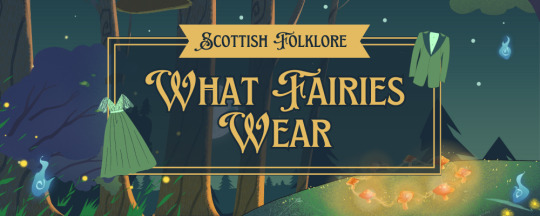
The colors fairies where can change depending on where they are, but most commonly in historical Scottish folklore(though not always), the color was green.

"Both, likewise, wore green garments, and were believed to take a spite against ordinary mortals who presumed to wear their colour. Among Highlanders, as doubtless among other peoples, there is a tendency to avoid selecting clothing of a green colour. Indeed, many women of our own day definitely refuse to wear anything that is green, on the ground that it is the colour in which the faeries specialise, and is, therefore, unlucky."
The Peat-Fire Flame: Folk-Tales and Traditions of the Highlands and Islands by Alasdair Alpin MacGregor (1937)
Because of it being such a common color for them, in stories the color can act as a warning sign that someone might not really be human.
"A ploughman while engaged at his work heard, or fancied he heard, a sound of churning, and said he wished his thirst “was on the dairymaid.” In a short time after a woman appeared and offered him a drink of buttermilk.
Her green dress and sudden appearance made him refuse the offer, and she said that next year he would not need the drink. When the twelve months were nearly out the man died."
Superstitions of the Highlands & Islands of Scotland by John Gregorson Campbell (1900)
However, green is not always the case. On Skye, only the women fairies tend to wear green, while the men wear whatever they want, but were often described in red.
"The Fairies, both Celtic and Teutonic, are dressed in green. In Skye, however, though Fairy women, as elsewhere, are always dressed in that colour, the men wear clothes of any colour like their human neighbours. They are frequently called daoine beaga ruadh, “little red men,” from their clothes having the appearance of being dyed with the lichen called crotal, a common colour of men’s clothes, in the North Hebrides."
Superstitions of the Highlands & Islands of Scotland by John Gregorson Campbell (1900)
This red colour sometimes applies to fairies on the boarder and into England.
Brownies are also a type a fairy, though commonly clothed in brown, and they are not the only ones.
"The usual dress of the Fairies is green; though on the moors they have been sometimes observed in heath-brown, or in weeds dyed with the stoneraw, or lichen."
Scottish Fairy and Folk Tales – Sir Walkter Scott(1893)

(Illustration from The Violet Fairy Book by Andrew Lang)
#fairies#fairy#fae#faeries#scottishfairies#scottishfolklore#FairyBasics#fairybasics#fay#scottishmyths#scottish myths#scottish mythology#folklore#scottish folklore#fairyart#ScottishFolkoreBasics
35 notes
·
View notes
Text
Second Sight

Second-Sight (taisch) is commonly used to refer to an ability to see a future death. This is usually an ability someone is gifted or born with.
“This receptive faculty, for power it cannot be called, is neither voluntary nor constant. The appearances have no dependence upon choice; they cannot be summoned, detained, or recalled–the impression is sudden, and the effect often painful.”
A JOURNEY TO THE WESTERN ISLANDS OF SCOTLAND by Samuel Johnson(1775)
Most often, the person has no control when the visions occur, or what the subject is. Due to their often morbid nature, the ability is often described as “unwanted.”
“Closely connected with death is the curious superstition about Second-sight, because it is with reference to death that its visions almost always occur.”
The Folk-Lore of the Isle of Man by A. W. Moore[1891]
Sometimes, this vision of death is simply just seeing a copy of yourself. This copy could die in front of you (showing you how it will happen) or simply be there to warn you that death is soon to come.
“A woman in Skye frequently saw a double of herself walking close by her. To make sure that it was her own double, she went out on different days in different articles of dress, which she found to be exactly copied by her spectral companion. This was, of course, regarded as a warning of her speedy death.”
The misty isle of Skye : Its scenery, It’s people, Its story” by Eneas Mackay, Stirling, (1927)
Second-sight does not always have to be grim, though. Sometimes, it simply involved being able to see invisible fairies or ghosts. For example, in one story by Lewis Spence in The magic arts in Celtic Britain (1874), a young man heard fairy music one night, and was invited by the fairies to dance and drink with them. He was allowed to depart, and was gifted with the sight from then on.
“He boasted of having seen and conversed with several of his earthly acquaintances whom the fairies had taken and admitted as “‘brothers’’.
The magic arts in Celtic Britain by Spence, Lewis, 1874-1955
This fairy and death connection might seem strange, but historically, the fairy realm and the realm of the dead were both thought to exist beyond the veil in The Otherworld. So, it would make sense that an ability connected to the dead may also hold a connection to the fairy world as well.
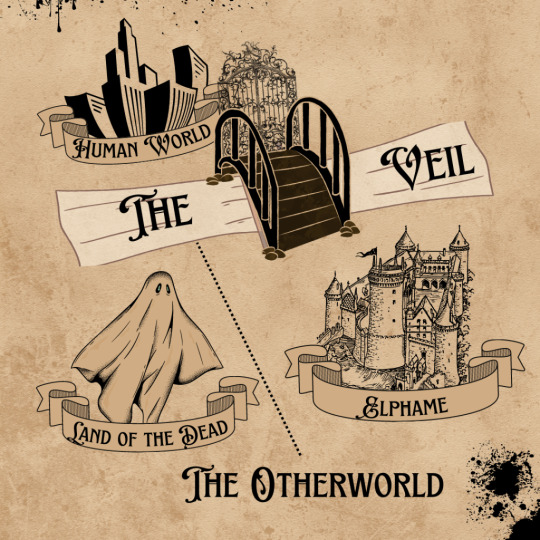
#fairy sight#second sight#secondsight#scottish folklore#scottishfolklore#scottishmythology#fairy#fairies#fae#FairyBasics#Folkmagic
12 notes
·
View notes
Text
What Are Fuath?

Fuathan (Fuath singular) have two different meanings associated with the name.
For one meaning, the name represents one singular type of creature. This creature has the shape of a man, but webbed hands and feet and a golden mane, and was popularized by folklorist John Francis Campbell in his book Popular Tales of the West Highlands.
“From all these it appears that the Fuath in Sutherland is a water spirit; that there are males and females; that they have web-feet, yellow hair, green dresses, tails, manes, and no noses ; that they marry men, and are killed by light, and hurt with steel weapons; that in crossing a stream they become restless.
From the following stories it appears that they are hairy, have bare skin on their faces, and have two large round eyes.”
Popular Tales of the West Highlands” by John Francis Campbell (1862)
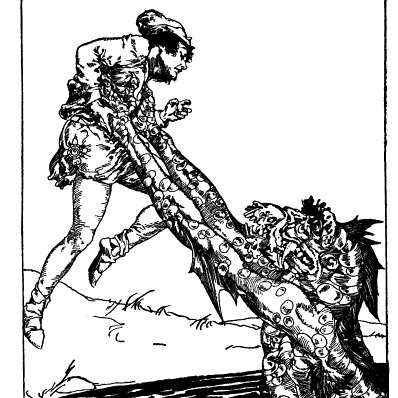
(A “fua” of the river grabs hold of a human.—Illust. Willy Pogany. Colum, Padraic (1916). King of Ireland’s son)
The second, and slightly more popular meaning, is that word as a category for several different types of water-type creatures with evil intent.
“Fuath: a spectre, a kelpie, a demon, a water-fiend frequenting glens, rivers, and waterfalls.”
Carmina Gadelica, Volume 2, by Alexander Carmicheal, [1900]
All it takes to be placed in the category is to be a water-type with evil intent; the hint of which is actually right in the name, which means “aversion,” or “hatred.”
The major differences to these meanings even caused a bit of debate between folklore writers.
“The attributes of the Fuath are different in different tales, and Mr. Campbell (Tales of the West Highlands, ii. 191) has fallen into the error of conjoining attributes ascribed in several stories, and representing the Fuath as a water spirit, having web-feet, tail, mane, etc.”
Witchcraft & Second Sight in the Highlands & Islands of Scotland by John Gregorson Campbell (1902)
Going by the second meaning, everything from a kelpie to certain water sprites may fall under the “fuath” category. In this way, it can be helpful to describe a creature in a story without knowing the exactly type. For example, if you say you were attacked by a fuath, people would know you mean an evil water-type creature.
In many stories, it is common for a person to be attacked by a fuagh, only for their dog to leap to protect them. In some stories, the dog wins but loses all of its hair.
“The dog at last disposed of the Vaugh , but he lost all his hair in the scuffle . The poacher became grey from terror in a single night , and we have reason to believe he did not again visit the pools of the Shin after dusk for any illicit purposes.”
THE VAUGH , THE POACHER , AND THE DOG from The Folklore Journal, Volume 6; Volume 21 By Folklore Society (Great Britain): The Folklore of Southerlandshire
Sadly, it is common for the dog to die the next day in stories.
Like with most fairies, they are affected by iron, but interestingly, some area also harmed by sunlight.
“One of John Ray Bethune’s forbears, who lived at Inveran, laid a bet that he would seize the kelpie of Moulinna Vaugha, or Moulinna Glannan, and bring her bound to the inn at Inveran.
He procured a brown , right-sided maned horse, and a brown black-muzzled dog, and by the help of the latter, having secured the Vaugh, he tied her on the horse behind him, and galloped away. She was very fierce, but he kept her quiet by pinning her down with an awl and a needle .
Crossing the burn at the further side of Loch Migdall, she became so restless that he stuck the shoemaker’s and the tailor’s weapons into her with great violence .
She cried out, “Och ! och ! cur anum am minme crourm ; L ‘ cum asum au ‘ hail chiul rouach,” which is, being interpreted,
“Pierce me with the crooked awl, but keep that small sharp needle ont of me.”
When he reached the clachan of Inveran, where his companions were anxiously waiting for him, he called out to them to come out and see the Vaugh. Then they came out, with lights, but as the light fell upon her she dropped off, and fell to earth, like the remains of a fallen star, a small lump of jelly.
[ These jellies are often seen on the moors , and are called “dropped stars.” ]
The Folklore Journal, Volume 6; Volume 21 By Folklore Society (Great Britain): The Folklore of Southerlandshire
So, putting this all bluntly, a fuath is commonly a category of water fairies that have a tendency to be evil, but some people use it to describe a single creature type.
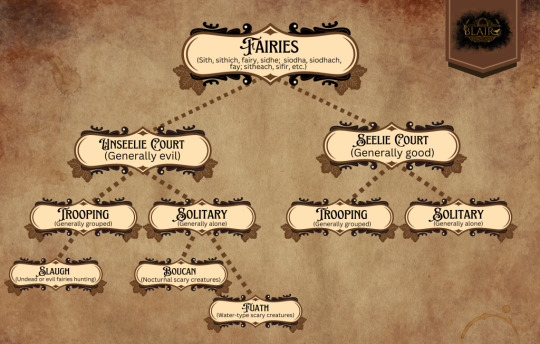
#fuath#fauth#scottishfolklore#scottish folklore#scottish myths#scottish mythology#FairyBasics#fairybasics#FairyTypes#fairytypes#fae#faerie#fae folk#fairies#fairy#unseelie#unseeliecourt#ScottishFolkoreBasics#MiscScottishFairies#WaterTypeFairies
31 notes
·
View notes
Text
What do you call fairies?
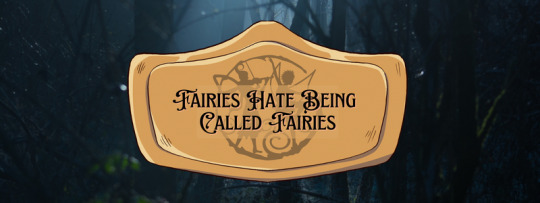
"Never speak ill of the deil” is a proverbial maxim, for mortal man never knew when his Satanic majesty might be within earshot. The invisible and alert fairies for the same reason were always mentioned with a honeyed tongue. The wily, knowing not where they might be lurking, were careful to call them “the good neighbours,” “the honest folk,” “the little folk,” ”the gentry,” “the hill folk ,” and ”the forgetful people,” the ”men of peace.‘
Klippe is the Forfarshire name for a fairy."
Folk Lore in Lowland Scotland by Evelyn Blantyre Simpson (1908)
Alright, so, all this time I have been calling them “fairies,” and there are other names as well that they are often called.
“The term “fairy’ now covers a large area, the Anglo-Saxon and Scandinavian elves, the daoine sidhe of the Highlands, the tuatha de danann of Ireland, the tylwyth teg of Wales, the seelie court and the unseelie court, the wee folk, and good neighbours and many others. The trooping fairies and the solitary fairies are included in it, the fairies of human or more than human size, the three-loot fairies and the tiny fairies; the domestic fairies and those that are wild and alien to man; the subterranean fairies and the water fairies that haunt lochs, streams or the sea.”
A Encyclopedia of Fairies by Katharine Briggs (Published in 1976)
Keep in mind that the historical Scottish use of "fairy" was not a term for one creature that looked or acted one specific way, but instead a category for many different creatures (more on that here). For a quick example of this, you can compare how radically different creatures with "Sìth" in the name can be; such as the Cù Sìth or Baobhan Sìth.
Some of the commonly used fairy names you may recognize, while others you may not.
"Sith, sithich, fairy, fairies; ‘siodha,’ ‘siodhach,’ fay, fairy; ‘bean sith,’ ‘sitheag,’ female fairy, ‘sitheach,’ ‘sifir,’ ‘sifire,’ ‘sifreach,’ male fairy.
The fairies entered largely into the lives and folklore of the Highland people. They lived in the green knolls and round hillocks, and only occasionally appeared to mortal eyes."
Carmina Gadelica, Volume 2, by Alexander Carmicheal, [1900]
So, which of those do they like to be called? None, apparently! According to historic Scottish folklore, terms like “fairy” is like a slur, and if you are overheard saying it, the listener may take offence. This is why those a little more superstitious are often heard calling them other things.
"The name of fairy was not pleasing to them, and men spoke of them as “the fair folk,” or “the gueede neebours."
Folklore of the North East of Scotland by Walter Gregor (1881)
For example: The Good People, The Fair Folk, The Good Neighbours, The People of Peace, and so on. These terms were seen as a less dangerous way to refer to a fairy.
Keep in mind that most fairies are said to be invisible, so people were always scared about who might be listening.
"The Scottish Fairies, in like manner, sometimes reside in subterranean abodes, in the vicinity of human habitations, or, according to the popular phrase, under the “door-stane,” or threshold; in which situation they sometimes establish an intercourse with men, by borrowing and lending, and other kindly offices. In this capacity they are termed “the good neighbours,” from supplying privately the wants of their friends, and assisting them in all their transactions, while their favours are concealed."
Scottish Folk and Fairy and Folk Tales by Sir Walter Scott (1893)
Now you might be wondering, what about fae? Well, "fay" is just an older spelling of fairy, and fae is an alternative spelling.
"The word fairies' is late in origin; the earlier noun is FAYS, which now has an archaic and rather affected sound."
A Encyclopedia of Fairies by Katharine Briggs (Published in 1976)
Perhaps because of that, "fay" and it's alternative spellings never appear in my historical Scottish sources that I have noticed. Instead, it is always "fairy" in either English, or Gaelic. That is not to say that the modern use of the word is wrong, because folklore does change over time, just that it does not appear to have been used in that context in the sources I find for Scottish specific historical folklore.
#fairies#fae#fair folk#scottish folklore#scottish mythology#FairyBasics#fairy#myths#sith#sidhe#mythology#mythological creature#mythological#faeries#fay#aos si#ScottishFolkoreBasics
34 notes
·
View notes
Text
Scottish Folklore for Holy

There are many plants thought of protective in Scottish folklore, and Holly(cuileann in Gaelic) is one of them.
Holly . This name is probably a corruption of the word holy , as this plant has been used from time immemorial as a protection against evil influence .
Folk Lore: Superstitious Beliefs in the West of Scotland within This Century By James Napier
Much like rowan, holly could be placed inside the house above the door as a protective seal. If done, this plant was said to protect against evil intent(including from fairies), and nightmares.
The HOLLY . Pieces of holly along with rowan were placed inside over the door of the stable to prevent the entrance of the nightmare . My informant has cut the tree for this purpose.
The Folk-lore Journal (Pg41): SOME FOLK – LORE ON TREES , ANIMALS , AND RIVER FISHING , FROM THE NORTH – EAST OF SCOTLAND
If planted near the house (outside) it was also said to protect from lightning. As it turns out, they may have been right.
“We now know that the spines on the distinctively-shaped holly leaves can act as miniature lightning conductors, thereby protecting the tree and other nearby objects.”
The Holly Society,
It was considered bad luck to cut down a holly tree, but cutting of boughs for use was allowed.
The only time the tree was never to be trimmed was if they grew in in boarder hedges, due to the belief that witches would run on top of hedges, but the holly would act as a barrier to stop them.
It is even said that in 1861, the Duke of Argyll even had a prospective road rerouted to avoid cutting down the holly there.

#scottish folklore#sidhe#sith#FairyBasics#scottish#fairies#fairy#mythology#folklore#scottish mythology#scottish myths#ScottishPaganism#ScottishFolklore#scottish history#Scottish Folklore and History#holly#pagan#paganism#scottishpagan#scottish pagan#scottish paganism#scottishpaganism#witchcraft
10 notes
·
View notes
Text
Changelings | Scottish Folklore

The first recorded fairy changeling was in the 16th century, but they likely have a history older than that. Changeling stories, however, are quite dark and disturbing, so leave now if you are not in the right mindset to handle that. There are mentions of child harm and murder ahead.
"When they succeeded in their felonious attempts, the elves left instead of the mother, and bearing her semblance, a stock of wood (stoc maide), and in place of the infant an old mannikin of their own race."
Superstitions of the Highlands & Islands of Scotland by John Gregorson Campbell (1900)
Both adults (particularly mothers) and babies were susceptible of being changelings. The mothers were said most often to be taken to help care for fairy babies, while the babies were taken for four main reasons.
The first is that the baby was swapped out for an elderly fairy, so that it can live out the rest of it’s days in comfort. This is why some changeling babies are said to not live long.
The second is because the fairies owed souls to the devil.
Every seven years they had to pay “the teind to hell,” and to save them from paying this tribute with one of themselves they were ever on the alert to get hold of human infants.
Folklore of the North East of Scotland by Walter Gregor (1881)
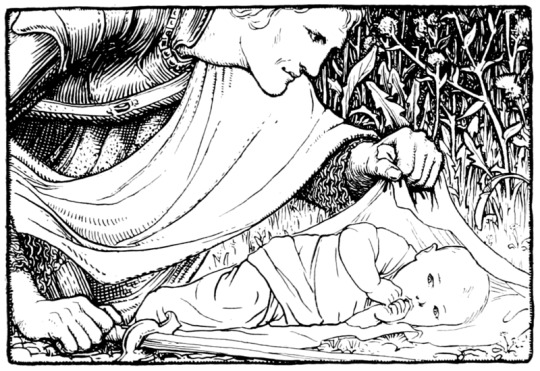
The forth (though less common) reason is that, for whatever reason, the fairy mother can not care for her own baby, and is swapped to save it. One story that sort of confirms this (though without a changeling) a fairy woman asks a mother to nurse her child and leaves. The mother does, and when the fairy comes back, the mother is blessed with good fortune.
In the cases where the baby is simply taken, a piece of wood is enchanted to look and act like a baby.
To prevent a mother or baby being taken away, they would have to be sained. To get a baby or mother back, sometimes all it would take was saining the changelings.
"He knew at once what was going on, and what was to be done, and he ran with all his speed to the smith’s house and “sained” the mother and her baby-an act which the nurse had neglected to do. No sooner was the saining finished than a heavy thud, as if something had fallen, was heard outside the house opposite to the spot where stood the bed on which the mother and her baby lay. On examination a piece of bog-fir was found lying at the bottom of the wall. It was the “image” the fairies were to substitute for the smith’s wife."
Folklore of the North East of Scotland by Walter Gregor (1881)

Other times, the customs to get rid of a changelings either involve tricking the fairy into giving itself away, or by hurting the baby so that the spell is either broken. This is when things will get quite dark, so again, this is your warning.
"The changeling was converted into the stock of a tree by saying a powerful rhyme over him, or by sticking him with a knife. He could be driven away by running at him with a red-hot ploughshare; by getting between him and the bed and threatening him with a drawn sword; by leaving him out on the hillside, and paying no attention to his shrieking and screaming; by putting him sitting on a gridiron, or in a creel, with a fire below; by sprinkling him well out of the maistir tub; or by dropping him into the river. There can be no doubt these modes of treatment would rid a house of any disagreeable visitor, at least of the human race."
Superstitions of the Highlands & Islands of Scotland by John Gregorson Campbell (1900)
There are many historical recordings on Tobar an Duelchais of fairy changelings being put onto a shovel, and held above the fire, and in other stories (such as from The Fairy Mythology / Illustrative of the Romance and Superstition of Various Countries by Thomas Keightley (1850) ) the baby is quite literally thrown into the fire.
If the changeling was indeed a fairy in disguise, the fairy will leave the real baby behind and scramble up the chimney.
"One day an old highland woman having seen the child , and inspected it carefully , affirmed that it was a fairy child . She went the length of offering to put the matter to the test , and this is how she tested it . She put the poker in the fire , and hung a pot over the fire wherein were put certain ingredients , an incantation being said as each new ingredient was stirred into the pot . The child was quiet during these operations , and watched like a grown person all that was being done , even rising upon its elbow to look . When the operations were completed , the old woman took the poker out of the fire , and carrying it red hot over to the cradle , was about to burn the sign of the cross on the baby’s brow , when the child sprung suddenly up , knocked the old woman down and disappeared up the lum ( chimney , ) filling the house with smoke , and leaving behind it a strong smell of brimstone . When the smoke cleared away , the true baby was found in the cradle sleeping as if it never had been taken away."
Folk Lore, Or, Superstitious Beliefs in the West of Scotland Within this Century by James Napier (1879)
There is a major dark side to these stories. All it took for a baby to be accused of being a changeling was simply crying more and louder than normal, which could, of course, lead to human babies being gravely injured. As well as that, often, some people born with deformities were accused of being changelings their entire life.
There are also murders to mention as well. The best known case of this happened in Ireland. Bridget Cleary was accused of being a changeling in 1895, simply for having bronchitis. I wont go into the gruesome details, but she was tortured to death by her husband and father. She was later (including by some today) called a witch, and described as the last witch burnt in Ireland.
This led to the nursery rhyme:
Are you a witch,
Or are you a fairy,
or are you the wife of Michael Cleary?

More Research:
Audio Recordings:
(link) A fairy changeling forced out. 1987,
(link) A family story about getting rid of a fairy changeling. 1984
(link) A changeling left by a fairy was not a real child and would never grow up properly. 1979
(link) A family story about getting rid of a fairy changeling. 1979
(link) The hump-backed tailor and the fairy. 1954
(link) Changeling gradually tortures a family to death. 1977
#ScottishFolklore#Scottish Folklore#folklore#FairyBasics#FairyTypes#Fairy#Fairies#Fae#Faeries#changlings#scottish#scottish mythology#ScottishFolkoreBasics#MiscScottishFairies
16 notes
·
View notes
Text
Seelie and Unseelie Courts


Both seelie court and unseelie court were once terms that were exclusively Scottish, but today many people use them for fairies elsewhere as well.
Part of the reason they are rapidly becoming so popular is because of their usefulness at how they categorize types of fairies. Fairies that generally do good are classified as “seelie court” fairies, but fairies who generally do bad are classified as “unseelie court” fairies.
“Members of the seelie court, which is the general Scottish name for the good FAIRIES, can be formidable enough when they are offended, but the Unseelie Court are never under any circumstances favourable to mankind.”
A Encyclopedia of Fairies by Katharine Briggs (Published in 1976)
It is important to note that this is not a clear cut case of good vs evil, because even if a fairy type spends most their time doing good or doing evil, they are capable of doing the opposite.
Kelpies (a man eating water horse) are a good example of this. Even though most their stories are of doing harm, occasionally, they do good as well. For example, in this story, a lonely widow is mourning the death of her only daughter all alone, when a Kelpie starts visting to chat with her.
A Skye Widow’s Strange Experience.
Once there lived at Vaterstein, in the west of Skye, an aged woman, whose daughter had been ailing for some time. At length the daughter died ; and all alone with the corpse in her dark, eerie home was the old woman left.
If you should visit this uncanny spot on a dark night, you will be able to judge for yourself how lonely and solitary the old mother must have felt during the long nights when lamps were unknown in Skye, and when only the meagrest artificial light could be produced.
Well, one night as she sat mourning her loss—so the story goes—who should enter her sorrowful home but a man whom she knew not ! He seated himself beside her; and, whenever the fire would be getting low, he would strike it with his magic stick, and say : ” chaorain, dean solus! O little peat, make a light ! ”
These were the days when the folks of Skye, and indeed of the Highlands and Hebrides generally, believed implicitly in the existence of the each-insge, or water-horse, a creature that had the power of assuming human form when occasion required. And the folks of Vaterstein were convinced it was the water-horse that all night long had sat with the lonely and bereaved widow, and vanished with the first flush of day
“The peat-fire flame : folk-tales and traditions of the Highlands & Islands” By Alasdair Alpin MacGregor (Published 1937)
So no, the Unseelie are not automatically evil murderers, and the Seelie are not impossible to do harm. While reading folklore, it is best to think of them as having the same complex personalities as people.
#unseelie#unseeliecourt#seelie#seeliecourt#fairy#fairies#fae#scottishfolklore#scottish folklore#folklore#mythology#FairyBasics#ScottishFolkoreBasics
17 notes
·
View notes
Text
What is a Fairy Ring 🍄 | Scottish Folklore
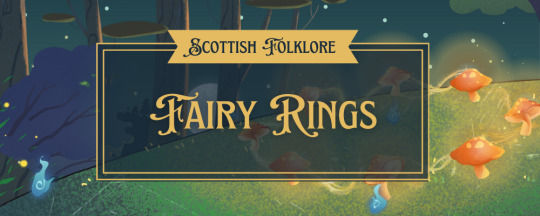
Historically, there are actually two different things that are called “fairy rings.”
The first I believe is exclusive to Ireland, and is now more commonly called a “fairy fort.” These forts are an elevated ring-shaped mound that is quite large. Some say that humans built a structure originally, then when the humans left, the fairies took it over. Other stories have a more traditional story, which I will talk about in a moment.
You can walk around the large rings yourself, but stepping into the center or causing it disrespect it not a good idea. I once talked to an Irish man while I was at a fairy fort in Ireland. He was still superstitious in the old ways, and said he once saw a tourist urinate into a fairy fort, and did not make it very far before breaking his leg.
The second type of fairy ring is the kind most people today are familiar with; it is a mysteriously perfect circle made of moss, or grass, or mushrooms, or some sort of other living growth.
"The trooping fairies can be large or small, friendly or sinister. ‘They tend to wear green jackets, while the solitary fairies wear red jackets. They can range from the heroic fairies to the dangerous and malevolent SLUAGH or those diminutive fairies who include the tiny nature fairies that make the fairy rings with their DANCING and speed the growth of flowers."
A Encyclopedia of Fairies by Katharine Briggs (1976)
Both these types of fairy rings are often said to be caused by fairies dancing in a circle, or sometimes by fairies riding horses in a circle.

Stepping into a ring or causing it destruction could lead to several different things: including being transported to the otherworld, being cursed, being forced to dance, and more.
If you were trapped, dancing there, you would need a rescuer to help pull you out, or touch you with iron or rowan.
‘I remember how an old woman pulled me out of a fairy ring to save me from being taken.’
The Fairy-Faith in Celtic Countries by W.Y. Evans-Wentz (1911)
So, to sum it up, a fairy ring could be a place of play where a magic mark is left from fairies the night before, or perhaps it is their portal to the Otherworld. No matter the answer, disrespecting one of these places is said to bring bad things your way, even if not immediately.
"He wha tills the fairies’ green
Nae luck again shall hae :
And he wha spills the fairies’ ring
Betide him want and wae.
For weirdless days and weary nights
Are his till his deein’ day.
But he wha gaes by the fairy ring,
Nae dule nor pine shall see,
And he wha cleans the fairy ring
An easy death shall dee."
A Scottish Rhyme

("Plucked from the Fairy Circle". A man saves his friend from the grip of a fairy ring.)
#FairyBasics#scottishfolklore#scottish folkore#scottish myths#scottishmythology#folklore#sidhe#sith#fairy#fairy rings#fae folk#ScottishFolkoreBasics
9 notes
·
View notes
Text
Should You Leave Offerings for Fairies? | Scottish Folklore
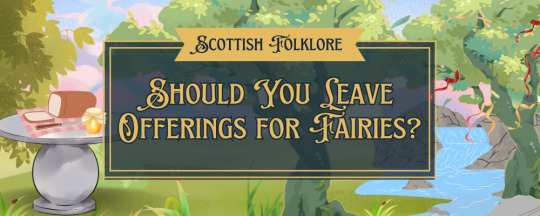
This post will be different in opinion from the common modern one, so for a quick disclaimer: having different folklore from mine does not make yours wrong. Different areas may have different fairy rules, and stories can change over time.
My sources tend to be late 1800’s to early 1900’s in Scotland, so not exactly modern.
My point is that you are all more than welcome here, even if you don’t agree, and please don’t sharpen your pitchforks and come after me.
Yes, you can leave offerings for fairies.
I know that the general modern advice is “don’t leave offerings or give gifts to fairies,” but historically in Scotland, many people did leave offerings and actually felt like it was necessary to.
As well as that, some people still leave out offering even today. There are elderly people who follow old traditions, and people visit clouty trees and other locations to leave offerings specifically with fairies in mind.
Brownies are the most common example of offering gifts in folklore. They are a type of domestic fairy that will help with chores in exchange for gifts of food.

(Illustration of a brownie by Alice B Woodward)
They are not alone in this custom, either. Even those so-called “Christmas gnomes” are actually from Scandinavian folklore, and have many different names(including tomte, nisse, tomtenisse, and tonttu) and seem to be cousins of the brownie. You treat them well, and they help with chores.
There are some dangers for leaving gifts. For example, leaving a gift other than food may cause them to leave, and forgetting to give something all together may offend them and lead to pranks.
Another example is the cat-sith. For that fairy (whose name means “cat fairy”), people would leave out a bowl of milk during Halloween for the cat-sith and also try to distract it with games when people died.
So yes, people have historically left out gifts for fairies without harm, and some still do today.
#faeries#fae#fae folk#faerie#fairies#fairy#scottishfolklore#scottish folklore#scottish mythology#scottish myths#FairyBasics#fairybasics#sith#sidhe#ScottishFolkoreBasics
5 notes
·
View notes
Text
Should You Accept Gifts or Help From Fairies?

Should you accept gifts from fairies? Possibly.
There is the common story of “never accept a gift from a fairy,” and it is no wonder with quotes like these:
"In every instance, however, the benefit of the gift goes ultimately to the Fairies themselves, or (as it is put in the Gaelic expression) ‘the fruit of it goes into their own bodies’ (Theid an toradh nan cuirp fhéin). Their gifts have evil influence connected with them, and, however inviting at first, are productive of bad luck in the end. No wise man will desire either their company or their kindness. When they come to a house to assist at any work, the sooner they are got rid of the better. If they are hired as servants their wages at first appear trifling, but will ultimately ruin their employer. It is unfortunate even to encounter any of the race, but to consort with them is disastrous in the extreme."
Superstitions of the Highlands & Islands of Scotland by John Gregorson Campbell (1900)
There is also the story (that I have mentioned before) where a kelpie offers to carry a man across a river, and the man would have been killed if he had not gotten away. There is even a type of fairy called the Dracæ who takes the form of treasure, only to be a trap.
However, most the stories I come across do not mention the evil that befalls someone who refuses a gift, but instead the insult that refusing a gift will bring.
"Even animals could call forth their anger; and, when they did so, they had to pay the penalty. One evening, “ atween the sin an the sky,” a man was ploughing with his “twal-ousen plew,” when a woman came to him, and offered him bread and cheese and ale. The man took the gift. Whilst he was enjoying his repast the good woman proceeded to give each of the oxen a piece of cakes. One by one the oxen took what was given, except the “wyner.” After partaking of the woman’s kindness, and she had left, the ploughman began his work again. All went on as usual till the plough reached the end of the furrow, when the “wyner,” that had refused to take the piece of cakes from the hands of the stranger, fell down, and broke his neck, as he was turning into the next furrow. The stranger was a fairy."
Notes on Folk-Lore of the North-East of Scotland by Walter Gregor, M.A. (1881)
There are many stories of fairies who take pity on humans. For example, there is a story of a man who was freezing to death in a cattle shed in Argyll, and woke in the night to find patchwork quilts all over him. However, they were gone in the morning. A broonie had cared for him all night.
In another story ,in a glen in Argyllshire, a shepards wife went into labour. He went to go fetch the doctor, but when he returned, he found that the broonie had safely delivered the child.
There are also countless stories of fairies intervening to help poor people, such as one where a brownie gives a man a bottle that produces money.
"A smith, the poorest workman in his trade, from his inferior skill, only got coarse work to do, and was known as the “Smith of Ploughshares” (Gobhainn nan Soc). He was, besides, the ugliest man, and the rudest speaker. One day he fell asleep on a hillock, and three Fairy women, coming that way, left him each a parting gift (fàgail). After that he became the best workman, the best looking man, and the best speaker in the place, and became known as the “Smith of Tales” (Gobhainn nan sgial)."
Superstitions of the Highlands & Islands of Scotland by John Gregorson Campbell (1900)
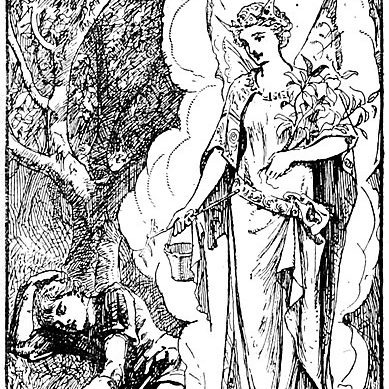
(Illustration from “The Twelve Dancing Princesses” in The Red Fairy Book, 1890.)
There is evena storywhere a woman is cursed to die by her mother-in-laws witchcraft, and the brownie works with her husband to save her.
Then of course, we can not forget The Black Chanter of Clan Chattan which was gifted to a Macpherson piper by a fairy in love with him, the Mackay’s fairy flag, and the famous Macleod fairy flag.
So is it a bad idea to accept gifts or help from fairies? To this I can only answer: maybe.
"There is a proverb-
‘ Na diult lamh sithiche,’
‘ Do not refuse the hand of a fairy ‘"
Highland Mythology by Watson, E. C. (1908)
#fae#fairies#fairy#scottishfolklore#scottish folklore#folklore#mythology#sidhe#sith#FairyBasics#ScottishFolkoreBasics
8 notes
·
View notes
Text
The Otherworld

Did you know that the answer to why Nessie will never be caught is in folklore?
To begin, I’m going to try to break down the Otherworld as I understand it from my experiences reading folklore, but as simply as possible in modern terms.
The otherworld is a world that is not separate from ours, but instead overlays it. Think of the Otherworld as a world that blankets ours.
"The Celtic Otherworld is like that hidden realm of subjectivity lying just beyond the horizon of mortal existence , which we cannot behold when we would , save with the mystic vision of the seer ."
The Fairy-Faith in Celtic Countries by W.Y. Evans-Wentz (1911)
There was one story where this stuck with me, though I can’t remember its source. In it, a baby was taken by a fairy. The mother could feel the baby was nearby and could sometimes even hear her baby, but she could not reach it. It was beside her and yet just beyond the veil in the Otherworld.
This otherworld has the kingdom of the fairy queen, which is often called Elphame, as well as the land of the dead. Think of those two as separate territories. I keep them as separate stories, due to fairies like the cait-sith.
The land of the fairies is often said to be a place of beauty, and any dwelling lavishly furnished. If they mean to trap a human there, they need only to offer a meal. The problem is that humans in folklore don’t always know they are in the Otherworld, they simply think they are in a nice place with nice people. If they eat the meal, they are trapped.

The 'Land of the Ever Young' depicted by Arthur Rackham in Irish Fairy Tales (1920).
One of the biggest challenges to the fairy world is that time passes differently than ours. Sometimes, a person can be gone for what seemed like years for them, when only moments passed here. Other times, a short amount of time has seemed to pass, only for the human to return to the human world, and discover the world has changed drastically, before time catches up and turns the human into dust.
"All idea of the flight of time was lost by them under the beauty of fairyland and the joy of life in it. When the fairy-thralls did at last return to earth, they found their places filled by others, and the memory of them well-nigh dead. It was only after many explanations the remembrance of them returned to friends and acquaintances, and they themselves came to know how long they had dwelt in fairyland."
Folklore of the North East of Scotland by Walter Gregor (1881)
For most of the year, our world and the Otherworld are separated by a veil. This barrier is often too strong to pass through, but there are places that act as exceptions. In these special places, the otherworld leaks into our world, like bridges between worlds. These “bridges”” are things like fairy mounds and fairy rings. They exist in both worlds, and is often hidden to ours.
Fairy mounds act as a home for fairies who like to visit both worlds. Sometimes, humans are tricked to enter these places, or do so by accident, and are trapped. In most tales, they can only be rescued after a year and a day. (Note: a year and a day plays a big part in Scottish folklore and customs. For example, hand-fasting was originally a ceremony for a temporary Marriage, which would last a year and a day. After which, the couple would decide if they wanted to be married for real).
They were believed to dwell inside green sunny hillocks and knolls, beside a river, a stream, or a lake, or by the sea-braes, in gorgeous palaces furnished with everything that was bright and beautiful.
Folklore of the North East of Scotland by Walter Gregor (1881)
So, putting it bluntly, the fairies who live in these mounds lock or unlock a gate to our world as they please. They also guard these areas from other fairies. For example, the home of kelpies are only ever said to be inhabited by kelpies. This explains why fairies like Kelpies don’t simply disappear when they are in danger, and instead run for their watery homes; to get through to the fairy world, they must reach a portal.
For cross-quarter days, the veil thins, allowing all sorts of fairies to our world. During Samhain, the veil is at its absolute weakest, and that is when even the dead are said to walk with us.
So now, back to Nessie. The folklore answer to why she is never caught would be because there is a “bridge” between our world and the other world that likely is also her home.
"Sìthein (pron. shï-en) is the name of any place in which the Fairies take up their residence. It is known from the surrounding scenery by the peculiarly green appearance and rounded form. Sometimes in these respects it is very striking, being of so nearly conical a form, and covered with such rich verdure, that a second look is required to satisfy the observers it is not artificial. Its external appearance has led to its being also known by various other names."
Superstitions of the Highlands & Islands of Scotland by John Gregorson Campbell (1900)
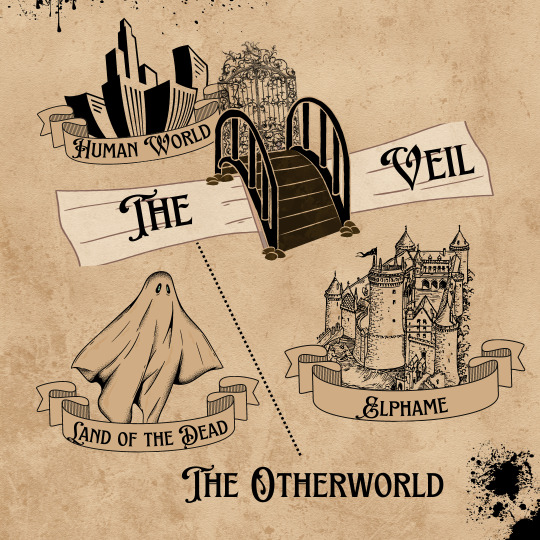
#fairy#fairies#fae#folklore#scottishfolklore#scottish folklore#mythology#FairyBasics#ScottishFolkoreBasics
8 notes
·
View notes
Text
Protection From Fairies: Rowan

“Black luggie , lammer bead ,
Rowan – tree and red thread ,
Put the witches to their speed.”
Notes on the Folk-lore of the Northern Counties of England and the Borders by William Henderson (1879)
Historically, Rowan is was likely the most relied upon tree in Scotland for protection against fairies and witchcraft. This includes it being carried as a sprig, or used under thatch or above doors.
“If the remains of the worship of particular trees are scanty in the North, there is no lack of evidence as to the virtues and powers believed to inhere in the mountain ash or rowan.. The rowan was protective rather than generative. It did not bring blessing so much as ward off evil. This belief sprang from an age when it was conceived as the abode of a good spirit, hostile to the powers of darkness.”
Primitive Beliefs in the North-East of Scotland by Joseph McKenzie McPherson (1929)
This protection was said to protect from fairies, changlings, witches, curses, and the evil eye. Perhaps because of this, it was considered unlucky to cutdown rowan trees and rowan was never to be burned.
“Rowan, or mountain ash. The tree which, above all others, offered the best protection against fairy enchantments and witchcraft. As the Scottish rhyme goes:
Rowan, lamer [amber] and red threid,
Pits witches to their speed.
It will be noticed that all these are reddish, and the red berries of the row an-tree make it specially effective. A staff of rowan, a CROSS made of rowan, a bunch of rowan berries, all these were effective, and it was customary in the Highlands to plant a rowan-tree outside every house.”
A Encyclopedia of Fairies by Katharine Briggs (Published in 1976)
Rowan trees can live to around 200 years, so some of the trees planted outside of homes for protection are still outside homes to this day, though the current owners might not know the significance that the trees once held.
"Caorrann, caorrunn, rowan, mountain ash.
The rowan was sacred, and used in many forms about the homestead. ‘Failean caorruinn,’ a rowan sucker, or ‘fleasg caorruinn,’ a rowan wand, was placed over the lintels of the barn, byre, stable, sheep-fold, and lamb-cot, as a safeguard against witchcraft and malicious spirits. A twig of rowan was coiled into a circlet and placed beneath the milk boynes to keep the milk from being spirited away. A fire of rowan was sacred, and therefore the festival cakes were cooked with rowan faggots or other sacred wood.
A coffin, or a bier, or the spokes on which it was carried, was treated with especial reverence if made of the mountain ash.
Thou rowan tree before the door,
Thou shalt go under me to the burial place,
My face shall be put toward Dundealgan,
And a beautiful bier shall be made for me"
Carmina Gadelica, Volume 2, by Alexander Carmicheal, [1900]
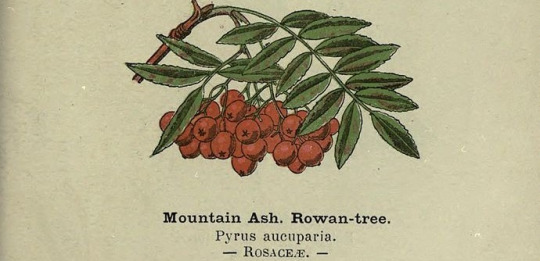

Historic Audio Recordings:
(link) 1964. Anne Ross asks about beliefs to do with iron. Allan Walker mentions that Highlanders didn’t believe an oath was binding unless they kissed a dirk. Iron and also rowan trees were supposed to keep away evil spirits. Mr Walker follows his father’s habit of taking a sprig of rowan tied with red wool when he goes fishing.
(link) 1955. There is a great belief in the evil eye. All the old steadings had an elder tree growing beside them [Donald Munro mentions some examples], and all the old houses had a rowan, if it would grow, to prevent the evil eye. The rowan won’t grow in sight of the sea, but in that case a piece of rowan was used under the thatch.
(link) 1964. People put sprigs of rowan above their door to ward off curses. Horseshoes were used in the same way, and could be seen in many byres.
(link) 1976. Rowans and steel to keep the fairies from replacing children with changelings.
(link) 1964. Rowan trees were planted near houses to ward off evil and witches. It was unlucky to cut down rowan trees.
(link) 1972. Old ruined cottages in the north usually have a rowan planted alongside. Juniper and rowan were also put in the byres and stables to keep the evil eye away.
#folklore#scottishfolklore#scottish folklore#scottish#mythology#fae#fairies#fairy#paganism#FairyBasics#animism#PaganScotland#Folkmagic
6 notes
·
View notes
Text

Protection from Fairies, Evil, and Witchcraft: St. John’s Wort
While today, St. John's Wort (also called Columba’s plant) is most commonly thought of for its use in fighting depression, historically, it was also important to folklore. In Scotland, it was thought to have protective qualities.
" If sought for, it has no efficacy more than another plant, but if accidentally fallen in with, and preserved, it wards off fever and keeps its owner from being taken away in his sleep by the Fairies."
Witchcraft & Second Sight in the Highlands & Islands of Scotland by John Gregorson Campbell(1902)
From warding off evil, enchantments, and even death, this herb was said to be able to do it all, but only if you came upon the plant by accident.
"St. John’s wort wards off enchantments, the evil-eye, even death itself, besides bringing plenty to house and field and fold. But it must be accidentally found, and ought to be placed secretly in a woman’s bodice or a man’s waistcoat under the armpit to ensure luck...-"
“The misty isle of Skye : Its scenery, It’s people, Its story” by Eneas Mackay, Stirling, (1927)
During Midsummer protective powers were thought to be stronger, so it was a common time for collecting the herb. It was hung in homes and barns for protection, or placed under a pillow.
"Saint John's wort is one of the few plants still cherished by the people to ward away second-sight, enchantment, witchcraft, evil eye, and death, and to ensure peace and plenty in the house, increase and prosperity in the fold, and growth and fruition in the field. The plant is secretly secured in the bodices of the women and in the vests of the men, under the left armpit. Saint John's wort, however, is effective only when the plant is accidentally found."
Carmina Gadelica, Volume 2, by Alexander Carmicheal, [1900]

#scottish folklore#sidhe#sith#FairyBasics#scottish#fairies#fairy#mythology#folklore#scottish mythology#scottish myths#ScottishPaganism#ScottishFolklore#scottish history#Scottish Folklore and History#Folkmagic
2 notes
·
View notes
Text
Protection From Fairies: Iron

Within Scottish folklore, fairies were known to occasionally kill or kidnap people, so there were many different protective charms that were used. One of the most common of those was iron, which as said to keep away fairies with evil intent, or even curses.
"Iron was a potent preservative. "Iron scares spirits." The belief springs from the time when iron was a new and mysterious metal. In the case of women in childbed, the safeguard took the form sometimes of a row of iron nails in the front board of the bed, sometimes of a smoothing iron, sometimes of a reaping-hook placed under the bed or in the window. Even a sword might be laid across the couch."
Primitive Beliefs in the North-East of Scotland by Joseph McKenzie McPherson (1929)
Even just putting a horseshoe above the door was said to keep away fairies with evil intent, or even curses.
"A horse-shoe was of great power for the protection of cattle against witchcraft. As in England, it must be found by accident."
Witchcraft & Second Sight in the Highlands & Islands of Scotland by John Gregorson Campbell (1902)
According to stories, even just needle in a bonnet, or a broken blade put up in a barn, it may be enough protection. Iron was even hung above a sleeping baby.
" Cold iron repels FAIRIES. A knife, or a cross of iron, arc sovereign protections against witchcraft and evil magic of all kinds. A pair of open scissors hung above a child’s cradle is said to protect it from being carried off by the fairies."
A Encyclopedia of Fairies by Katharine Briggs (Published in 1976)
Some claim that the iron is like poison to the fairies, but others claim that the iron was so feared due to it's ability to stop fairy magic. It could even be used to kill fairies, which is why it was so feared by Baobhan Sith and water horses.
"When he got the wind favorable, he killed and roasted a wither-sheep in the hut. The wind blew the savory smell towards the loch, and the Water-horse, attracted by it, made its way into the hut by the entrance left for it. The smith had his irons ready in the fire, and rushing with them at the Water-horse killed it. On examination the monster proved to be merely grey turves (pluic ghlas), or, as others say, a soft mass (sgling) like jelly-fish (Muir-tiachd)."
Superstitions of the Highlands & Islands of Scotland by John Gregorson Campbell (1900)
No matter which it is, the iron does not seem to bother domestic fairies. For example, broonies (brownies) are often described as helping with chores that would involve the use of iron tools. So it is likely that it only worked for evil intent.
"Smiths, being people who work among iron, were deemed of more virtue against the powers of evil than any other tradesmen."
Superstitions of the Highlands & Islands of Scotland by John Gregorson Campbell (1900)
3 notes
·
View notes